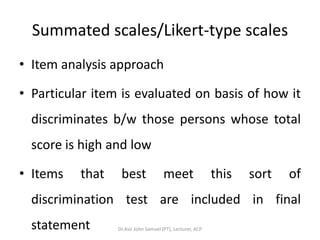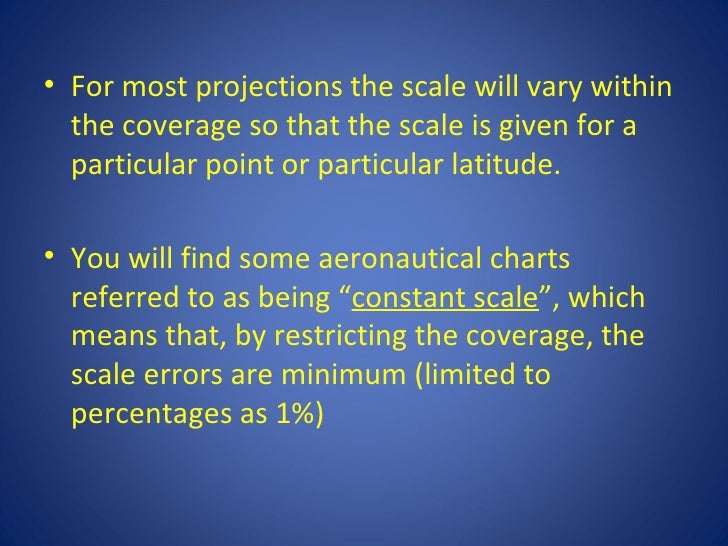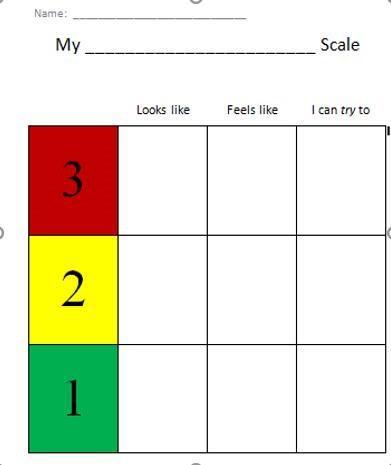44 response scales how many points and what labels
Choosing response scale labels and length: guidance for ... - ResearchGate There has been much debate over the optimal format for scales, particularly in regard to two key issues -the labelling of points and the overall length of response scales. PDF Typical Survey Response Scales - STLHE n Bipolar scales (Disagree to Agree) have a maximum reliability and validity at 7 points whereas unipolar scales (e.g., Not True at all to Completely True) have a maximum reliability and validity at 5 points (Krosnick & Fabrigar, 2003) n Numeric labels seem to increase confusion rather than verbal labels (Krosnick & Fabrigar, 2003)
Writing Good Surveys: Response Scales | Questionmark The idea behind this approach is that "never" and "always" should mean the same thing to every respondent, and that the use of numbers indicates an equal difference between each choice. However, a quick Googling of "survey response scales" reveals that many survey designers recommend just the opposite - that scale choices should all be labeled!

Response scales how many points and what labels
15 Common Rating Scales Explained - MeasuringU The classic Likert item uses a 5-point response scale, but you can use 7, 9, or other points, too. (Although someone will have a strong opinion about the "right" number of steps.) Because the response scale is about agreement, be sure items are phrases participants can agree or disagree to. (PDF) Choosing response scale labels and length ... - Academia.edu Euclidean distances of 5-point and 11-point scales 5-point scale Euclidean Distance 11-point scale Euclidean Distance Poor to Fair 2.5890 oto 1 0.9334 Fair to Good 1.1862 1 to 2 1.2221 Good to Very Good 0.8502 2 t03 2.2579 Very Good to Excellent 2.0090 3t04 1.6204 4t05 1.4897 5t06 0.4871 6to 7 0.5875 7t08 0.6135 8t09 0.9569 9 to 10 0.7957 Mean ... APA Dictionary of Psychology response scale. any of various types of instruments provided to a respondent to express an answer to an item. Examples of different response scales include fixed-alternative questions, Likert scales, visual analogue scales, and semantic differentials.
Response scales how many points and what labels. Survey Response Scales - Answer Format and Types of Questions - Explorable Three-point, five-point, and seven-point scales are all included in the umbrella term "rating scale". A rating scale provides more than two options, in which the respondent can answer in neutrality over a question being asked. Examples: 1. Three-point Scales Good - Fair - Poor Agree - Undecided - Disagree Extremely- Moderately - Not at all Writing Good Surveys, Part 4: Response Scales - Questionmark These are the scales that elicit the most amount of debate among the experts, and I strongly encourage you to Google "survey response scales" and do a little reading. The main points of discussion are number of responses, direction, and labeling. Number of Responses. We've all seen the minimalist approach to rating scales: Should All Scale Points Be Labeled? - MeasuringU For example, coming up with labels for each of the points on the eleven-point Likelihood to Recommend item would likely be impractical; endpoints and a neutral label may be all that can be done. But labeling each response option for five- and seven-point scales is practical and a fairly common practice. The 4,5, and 7 Point Likert Scale + [Questionnaire Examples] 3 Point Likert scale is a scale that offers agree and disagree as to the polar points along with a neutral option. Like the 2-point scale, the 3 point scale is also used to measure Agreement. Options will include: Agree, Disagree, and Neutral. 6 Points Likert Scale A 6 point Likert scale forces choice and gives better data.
What Is the Best Response Scale for Survey and Questionnaire Design ... points use for their survey and questionnaire. Taken as a whole this study suggests using of seven-point rating scale and if there is a need to have respondent to be directed on one side, then six-point scale might be the most suitable. Key Words Response Scale, Rating Scale, Attitude Scale, Liker Scale, Scaling Method, Response Rate, Type of response scales - SOCIOMETRIC RESEARCH FOUNDATION A relative metric scale is a kind of scale that also requires the specification of a standard to give relative evaluations. An absolute metric scale is where respondents should select a point on a continuum. Dichotomous scales only provides two substantive response options. Typical dichotomous scales are yes-no and true-false scales. 4 Measurement Scales Every Researcher Should Remember 1. Graphic Rating Scale. A graphic rating scale, also known as a continuous rating scale usually looks like the figure drawn above. The ends of the continuum are sometimes labeled with opposite values. Respondents are required to make a mark at any point on the scale that they find appropriate. A classification of response scale characteristics that affect data ... In total, they considered more than 280 possible choices, among which 40 choices are related to the design of the scale and belong to 17 characteristics. Table 2 in Appendix provides the list of response scales' characteristics and the choices considered by these authors.
How to Choose the Right Employee Survey Response Scales Numbers scales are: + Easy to analyze. + Easily expandable for more precise answers. For instance, expanding a five-point scale to seven or ten points. - Potentially subjective based on cultural differences. For instance, a seven on a ten-point scale could mean neutral or positive depending on where your respondents come from in the world. A classification of response scale characteristics that affect data ... In total, they considered more than 280 possible choices, among which 40 choices are related to the design of the scale and belong to 17 characteristics. Table 2 in Appendix provides the list of response scales' characteristics and the choices considered by these authors. Survey Rating Scales to Guide Survey Respondents Effectively Five point scales are most popular followed by seven point scales. These scale ranges tend to work best. Beyond a 7 point scale participants have trouble responding the same way if they repeated the survey, so we recommend staying away from anything above 7 points. Here is an example of a 5 point Likert Rating Scale: Strongly disagree Disagee Response Scales' Length - SOCIOMETRIC RESEARCH FOUNDATION Highest validity is with 4, 5 or 7p [True-score MTMM validity] (Scherpenzeel and Saris 1997) →YES* 5 AD points reduces extreme response style [Extreme Response Style through log odds] (Weijters et al. 2010) → YES* YES means that there is an effect on quality either positive or negative impact. NO means that there is no effect.
PDF Response scales - UIC half of respondents were randomly assigned to rate from 0 to 10 with endpoints labeled "not at all successful" and "extremely successful" half of respondents were randomly assigned to rate from -5 to +5 with endpoints labeled "not at all successful" and "extremely successful" only 9% of respondents rated their success either a "9" or a "10" on …
A Search for the optimum feedback scale Thus when defining an optimum response scale it is important to consider scales which are frequently used. The Mayflower organisation 2, which regularly implements surveys, has recommended four five-point scales found to be especially effective: 1) Far too much, too much, about right, too little, far too little.
Response Options - Designing Surveys for Evaluations and Research With Likert response scales, the issue is one of specificity and, in some cases, ordinality. Typically, a Likert scale will have four to eight options. The specific number should be informed by the respondents' ability to make clear differentiations between options on the scale.
(PDF) Choosing response scale labels and length: Guidance for ... the use of 10-point likert scales, compared to parallel choices with seven or five points, is motivated by the ability attributed to slow food members to perceive (also dedicating the necessary...
How Many Scale Points Should I Include for ... - Survey Practice Overall, two point scales were the most reliable followed by four, five, and nine point scales. Reliability was lower for six and seven point scales. The high reliability for two point scales could be due to the fact that two point scales only measure direction, whereas larger scales measure both direction and intensity (Alwin and Krosnick 1991 ...
Survey Response Scales: How to Choose the Right One - CXL Survey response scales can be embedded in the survey (e.g., 1-5, 1-10, etc.), chosen via a drop-down menu, or included as part of the survey language. No matter how you choose to display the scale, the default ranges affect the precision of your data. For example, if a survey asks your age, a default range of 20-25 instead of 20-30 has ...
PDF The Effect of Rating Scale Format on Response Styles: the Number of ... numbers of response categories and varying label formats (e.g., 7-point rating scales labeled at the endpoints, fully labeled 5-point scales, etc.) but have few guidelines when selecting a specific format. Drawing from the literature on response styles, we formulate hypotheses on the effect of the labeling of response categories and the
How to Label Response Scale Points in Your Survey | Qualtrics Here's an example of a seven-point bipolar scale where, through the use of appropriate modifiers, all responses are mutually exclusive of one another. Finally, to ensure that you get the highest-quality data possible, keep these four guidelines in mind as you practice labeling response scales:
PDF Choosing Response Scale Labels and Length: Guidance for ... - DRO Number of points Labels Balanced Mid-points Level of Measurement 18 Scale Types There are two generic types of scale -verbal scales and numeric scales -and almost unlimited versions of each type (Myers, 1999). Table 1 outlines the variables that con ... telecommunications company, using a 5-point response scale. Later in the (long) ques
Your Guide to Rating Scale Questions in 2022 - Qualtrics The scale's points should map as closely as possible to the underlying idea (construct) of the scale. Also, the scale should give enough points to differentiate respondents from one another as much as validly possible. It should be easy to interpret the meaning of each scale point - i.e. the meaning of scale points should be interpreted ...
APA Dictionary of Psychology response scale. any of various types of instruments provided to a respondent to express an answer to an item. Examples of different response scales include fixed-alternative questions, Likert scales, visual analogue scales, and semantic differentials.
(PDF) Choosing response scale labels and length ... - Academia.edu Euclidean distances of 5-point and 11-point scales 5-point scale Euclidean Distance 11-point scale Euclidean Distance Poor to Fair 2.5890 oto 1 0.9334 Fair to Good 1.1862 1 to 2 1.2221 Good to Very Good 0.8502 2 t03 2.2579 Very Good to Excellent 2.0090 3t04 1.6204 4t05 1.4897 5t06 0.4871 6to 7 0.5875 7t08 0.6135 8t09 0.9569 9 to 10 0.7957 Mean ...
15 Common Rating Scales Explained - MeasuringU The classic Likert item uses a 5-point response scale, but you can use 7, 9, or other points, too. (Although someone will have a strong opinion about the "right" number of steps.) Because the response scale is about agreement, be sure items are phrases participants can agree or disagree to.















Post a Comment for "44 response scales how many points and what labels"